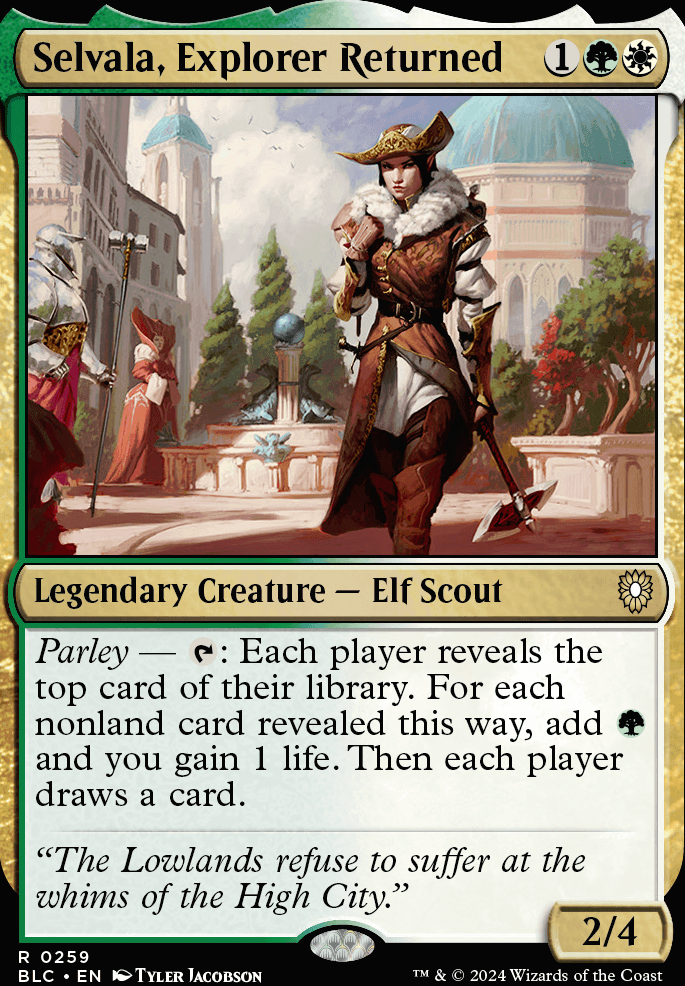Creature (27)
- 1x Arbor Elf
- 1x Avacyn's Pilgrim
- 1x Aven Mindcensor
- 1x Birds of Paradise
- 1x Boreal Druid
- 1x Dosan the Falling Leaf
- 1x Elvish Archdruid
- 1x Elvish Harbinger
- 1x Elvish Mystic
- 1x Elvish Visionary
- 1x Fauna Shaman
- 1x Fyndhorn Elves
- 1x Grand Abolisher
- 1x Karametra's Acolyte
- 1x Llanowar Elves
- 1x Marwyn, the Nurturer
- 1x Mirror Entity
- 1x Priest of Titania
- 1x Quirion Ranger
- 1x Ranger-Captain of Eos
- 1x Reclamation Sage
- 1x Seeker of Skybreak
- 1x Stoneforge Mystic
- 1x Temur Sabertooth
- 1x Village Bell-Ringer
- 1x Wirewood Channeler
- 1x Wirewood Symbiote
Artifact (9)
Land (31)
- 1x Arid Mesa
- 1x Bountiful Promenade
- 1x Brushland
- 1x Cavern of Souls
- 1x City of Brass
- 1x Command Tower
- 1x Dryad Arbor
- 1x Flooded Strand
- 6x Forest
- 1x Gaea's Cradle
- 1x Horizon Canopy
- 1x Mana Confluence
- 1x Marsh Flats
- 1x Misty Rainforest
- 2x Plains
- 1x Prismatic Vista
- 1x Razorverge Thicket
-
1x
Reflecting Pool

- 1x Savannah
-
1x
Temple Garden

- 1x Verdant Catacombs
- 1x Windswept Heath
- 1x Wirewood Lodge
- 1x Wooded Bastion
- 1x Wooded Foothills
Enchantment (13)
Commander (1)
Instant (15)
- 1x Autumn's Veil
- 1x Beast Within
- 1x Benefactor's Draught
- 1x Chord of Calling
- 1x Eladamri's Call
- 1x Enlightened Tutor
- 1x Force of Vigor
- 1x Nature's Claim
- 1x Noxious Revival
- 1x Silence
- 1x To Arms!
- 1x Veil of Summer
- 1x Vitalize
- 1x Worldly Tutor
Sorcery (4)
Suggestions
Updates Add
Comments View Archive
Attention! Complete Comment Tutorial! This annoying message will go away once you do!
Important! Formatting tips — Comment Tutorial — markdown syntax
Please login to comment
| Top Ranked |
|
| Date added | 6 years |
| Last updated | 5 years |
| Legality | This deck is not Commander / EDH legal. |
| Rarity (main - side) | 9 - 0 Mythic Rares 42 - 0 Rares 26 - 0 Uncommons 15 - 0 Commons |
| Cards | 100 |
| Avg. CMC | 1.96 |
| Tokens | Beast 3/3 G, Treasure |
| Folders | cEDH, CEDH, cEDH_Resources, Research, EDH, EDH, Dope but real expensive, Different Takes, Cool Decks to Try, liked |
| Votes | |
| Ignored suggestions | |
| Shared with | |
| Views |











